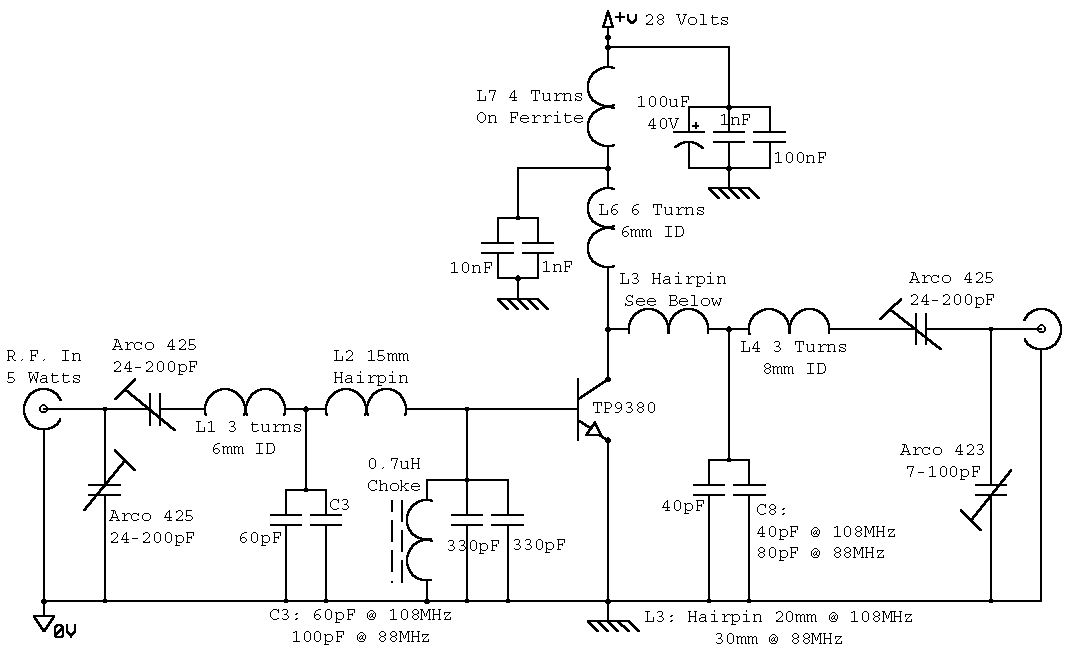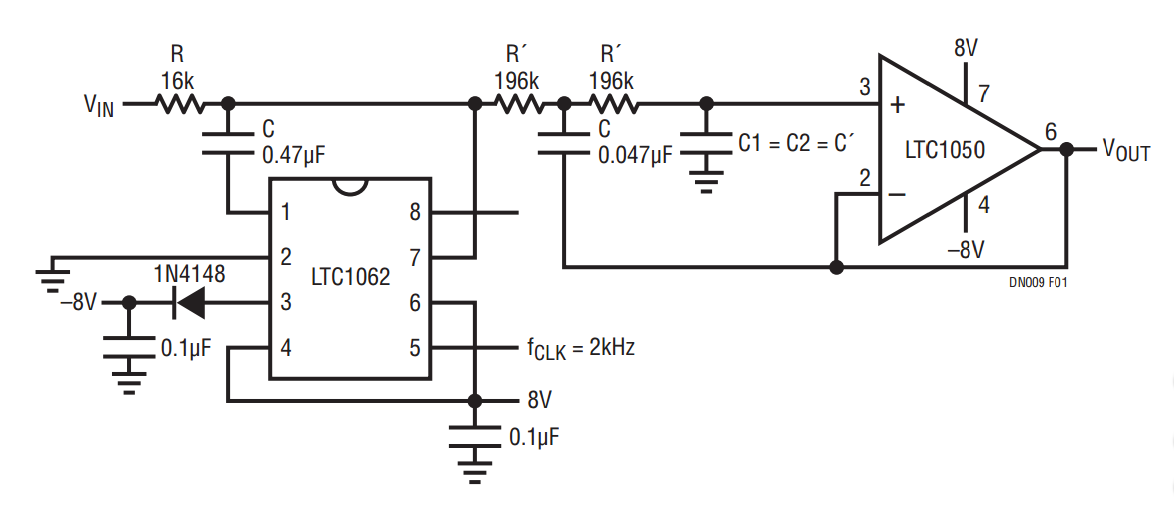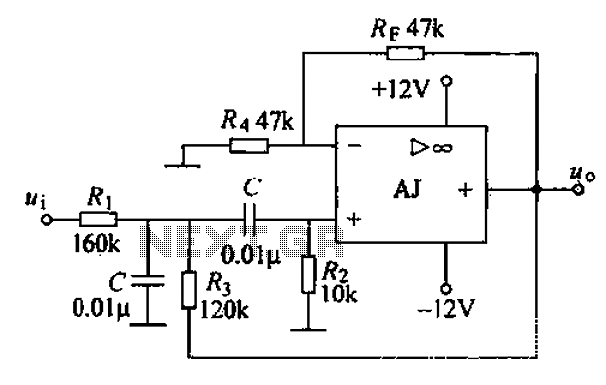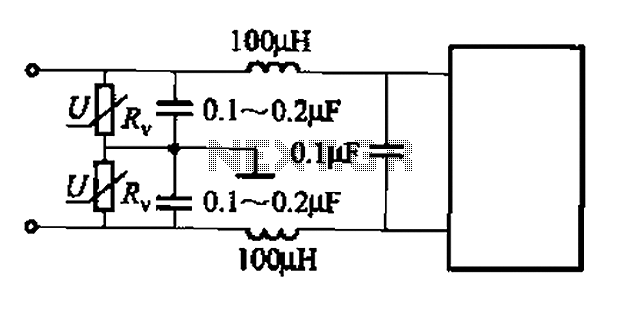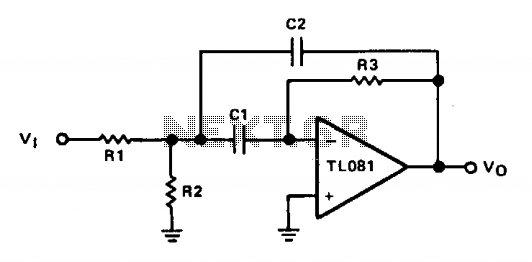
Notch Filter

At first glance, this circuit appears to be quite complex; however, it can be segmented into high-pass and low-pass filter sections, followed by a summing amplifier with a gain of approximately 20 times. The supply rail voltage is +/- 9V DC. The controls can also be adjusted to function as a band-stop (notch) filter or a band-pass filter. Additionally, it includes a variable notch filter with both high-pass and low-pass filters.
This circuit is designed to process audio signals, providing flexibility in filtering capabilities. The high-pass filter section is responsible for allowing frequencies above a certain cutoff frequency to pass through while attenuating lower frequencies. This is achieved using capacitive and resistive components configured to create a specific frequency response. The low-pass filter section, conversely, permits frequencies below a designated cutoff frequency to pass, while higher frequencies are reduced. This dual-filter approach allows for the selective manipulation of audio signals, enhancing specific frequency ranges while suppressing others.
The summing amplifier, which follows the filter sections, combines the outputs of the high-pass and low-pass filters. It is configured to provide a gain of approximately 20 times, which amplifies the resulting signal to ensure it is suitable for further processing or output. This amplification stage is crucial for maintaining signal integrity and ensuring that the output is robust enough for subsequent stages in an audio processing chain.
Moreover, the circuit's design allows for additional versatility through the adjustable controls. By modifying the filter parameters, the circuit can be transformed into a band-stop filter, which effectively eliminates a specific frequency range while allowing all others to pass. This is particularly useful in applications where unwanted noise or interference at a certain frequency must be minimized. Alternatively, the circuit can be adjusted to operate as a band-pass filter, allowing only a designated range of frequencies to pass while attenuating both lower and higher frequencies. This feature is essential in various audio applications, such as equalization, noise reduction, and sound shaping.
Overall, the combination of high-pass and low-pass filters, coupled with the summing amplifier and adjustable controls, provides a powerful tool for audio signal processing, allowing users to tailor the sound to their specific needs. The circuit's ability to operate with a supply voltage of +/- 9V DC ensures compatibility with a wide range of audio equipment, making it a versatile choice for both professional and amateur audio applications.At first glance this circuit looks fairly complex, but when broken down, can be divided into high pass and low pass filter sections followed by a summing amplifier with a gain of around 20 times. Supply rail voltage is +/- 9V DC. The controls may also be adjusted for use as a band stop (notch) filter or band pass filter. A variable notch filter with both high and low pass filters. 🔗 External reference
This circuit is designed to process audio signals, providing flexibility in filtering capabilities. The high-pass filter section is responsible for allowing frequencies above a certain cutoff frequency to pass through while attenuating lower frequencies. This is achieved using capacitive and resistive components configured to create a specific frequency response. The low-pass filter section, conversely, permits frequencies below a designated cutoff frequency to pass, while higher frequencies are reduced. This dual-filter approach allows for the selective manipulation of audio signals, enhancing specific frequency ranges while suppressing others.
The summing amplifier, which follows the filter sections, combines the outputs of the high-pass and low-pass filters. It is configured to provide a gain of approximately 20 times, which amplifies the resulting signal to ensure it is suitable for further processing or output. This amplification stage is crucial for maintaining signal integrity and ensuring that the output is robust enough for subsequent stages in an audio processing chain.
Moreover, the circuit's design allows for additional versatility through the adjustable controls. By modifying the filter parameters, the circuit can be transformed into a band-stop filter, which effectively eliminates a specific frequency range while allowing all others to pass. This is particularly useful in applications where unwanted noise or interference at a certain frequency must be minimized. Alternatively, the circuit can be adjusted to operate as a band-pass filter, allowing only a designated range of frequencies to pass while attenuating both lower and higher frequencies. This feature is essential in various audio applications, such as equalization, noise reduction, and sound shaping.
Overall, the combination of high-pass and low-pass filters, coupled with the summing amplifier and adjustable controls, provides a powerful tool for audio signal processing, allowing users to tailor the sound to their specific needs. The circuit's ability to operate with a supply voltage of +/- 9V DC ensures compatibility with a wide range of audio equipment, making it a versatile choice for both professional and amateur audio applications.At first glance this circuit looks fairly complex, but when broken down, can be divided into high pass and low pass filter sections followed by a summing amplifier with a gain of around 20 times. Supply rail voltage is +/- 9V DC. The controls may also be adjusted for use as a band stop (notch) filter or band pass filter. A variable notch filter with both high and low pass filters. 🔗 External reference

